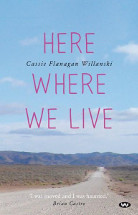Here where we live by Cassie Flanagan Willanski

Wakefield Press, 2016. ISBN 9781743054031
(Age: 16+) Recommended. The nine short stories in Here where we live
are set in South Australia but their themes are universal. Cassie
Flanagan Willanski's characters deal with those turning points in
life when complexity is unavoidable and choices are difficult.
Readers can recognise and be moved by the unintended consequences of
a child's impulsive behaviour, the passage from adolescence to
adulthood, the challenge of combining parenthood with long-held
dreams, divorce and the death of a partner. Intertwined with these
lives are the characters' relationships with Indigenous people and
the landscape. Attempts to reconcile conflicted feelings in personal
lives are mirrored in the search by Australians for reconciliation
with their history.
The author's use of language is economical but vivid. Whether
writing in the first or third person, as an adult or as a child, her
skill as a short story writer is evident in her ability to create
convincing characters and their worlds in a few pages. She also
ensures that her readers are constantly aware of the environment,
the physical sensations it evokes and its emotional impact.
Interactions between Indigenous and non-Indigenous people are
thought-provoking and capture the feelings of the participants - the
sadness and confusion caused by cultural misunderstanding, and the
peace of mind derived from shared experience and acceptance. Issues
such as the Hindmarsh Island Bridge controversy and atomic testing
in South Australia and Nevada are handled with sensitivity.
Here where we live is challenging, occasionally confronting,
multifaceted and satisfying literature for mature readers.
Elizabeth Bor